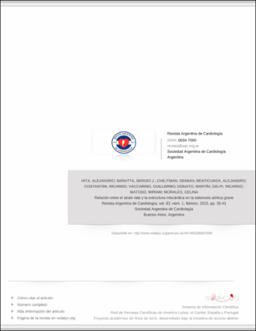Relación entre el strain rate y la estructura miocárdica en la estenosis aórtica grave

View/
Date
2015-02-01Author
Hita, Alejandro.
Baratta, Sergio.
Chejtman, Demian.
Benticuaga, Alejandro.
Costantini, Ricardo.
Vaccarino, Guillermo.
Donato, Martin.
Metadata
Show full item recordAbstract
Background: In severe symptomatic aortic stenosis (SSAS) altered global longitudinal systolic strain (GLSS) would correlate with changes in myocardial histological architecture and could identify early contractile involvement in patients with
preserved ejection fraction (PEF).
Objective: The aim of this study was to analyze GLSS, collagen volume (CV), myocyte area (MyAr) and contractile involvement in patients with SSAS and PEF.
Methods: Twenty six patients with SSAS and PEF (67±11 years old, 53% male) were included in the study. A preoperative hemodynamic study and an intraoperative endomyocardial biopsy were performed to determine CV and MyAr. Three
groups of patients were identified: G1: compensated left ventricular hypertrophy (LVH) without coronary disease (n=8); G2:
decompensated LVH without coronary disease (n=7) and G3: decompensated LVH with coronary disease (n=11). GLSS was
normalized by stroke volume, meridional end-systolic wall stress (δ) and end-diastolic diameter (EDD).
Results: No significant differences in stroke volume, δ and EDD were observed between groups G1, G2 and G3. Differences
between groups were observed in: CV (%) (G1: 4.7 ± 1.2, G2: 8.4 ± 1.2, G3: 11.0 ± 3.0; p < 0.01), MyAr (mm2
) (G1: 328.7
± 66.2, G2: 376.7 ± 21.9, G3: 385.0 ± 13.0; p = 0.01), LVEDP (mm Hg) (G1: 13.1 ± 1.5, G2: 19.0 ± 3.8, G3: 23.6 ± 5.8; p <
0.01), +dP/dtmax (mm Hg/sec / LVEDP, mm Hg) (G1: 176.4 ± 45.5, G2: 89.6 ± 20.1, G3: 113.1 ± 43.7; p < 0.01), and GLSS
(%) (G1: -17.9 ± 4.2, G2: -13.5 ± 2.5, G3: -13.6 ± 3; p = 0.021). GLSS correlated with CV and LVEDP and it evidenced a
trend to correlate with a contractility index (+dP/dtmax mm Hg/s / LVEDP, mm Hg).
Conclusions: Altered GLSS in patients with SSAS and PEF expresses myocardial structural changes related to increase in
CV, which is associated with enhanced LVEDP and probable myocardial contractile failure.

